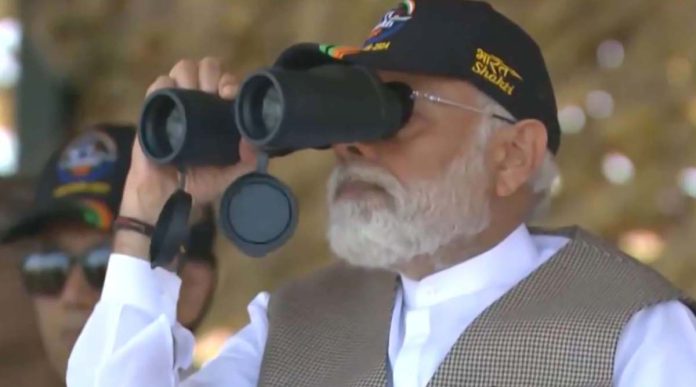Interaction Team
On March 12, 2024, India showcased its military might through the Bharat Shakti exercise, conducted in Porkhan, Rajasthan, proximate to Pakistan’s Tharparkar area. This event, heralded as a demonstration of India’s defense capabilities, has sparked a whirlwind of controversy and criticism, underpinning the complexities of nationalism, defense procurement, and the politics of military exercises. This article dissects the multifaceted aspects of the Bharat Shakti exercise, unveiling the discrepancies between its portrayal and reality, and evaluating its implications in the broader context of Indian defense strategy and political spectacle.
Misrepresentation of the exercise’s scope
Initially advertised as a tri-services exercise, the Bharat Shakti event predominantly featured land forces, raising questions about the transparency and accuracy of official claims. The absence of integral air force and naval operations from the exercise contradicts the tri-service collaboration essential for comprehensive national defense capabilities, suggesting a possible overstatement of the exercise’s scope and scale.
Political theatrics and ideological underpinnings
Prime Minister Narendra Modi’s appearance in an army uniform during the exercise was criticized as a strategic maneuver aimed at bolstering his image ahead of the imminent elections. Such actions are not unprecedented in political landscapes; however, Modi’s theatrics are scrutinized through a lens of ideological beliefs closely associated with the Rashtriya Swayamsevak Sangh (RSS). The RSS’s historical parallels with Nazi philosophy, particularly concerning notions of racial superiority, cast a shadow over the exercise’s narrative, intertwining military posturing with contentious ideological assertions.
The dichotomy of “made in India” claims
The Bharat Shakti exercise was a platform for showcasing India’s indigenous defense capabilities. However, scrutiny of the displayed weaponry reveals a stark divergence from claims of self-reliance. Lauded for its heavy armor, the Arjun tank’s operational limitations in high-altitude terrain and its suitability for only specific regions of potential conflict underscore the challenges of developing versatile military hardware within the constraints of geographical diversity.
The portrayal of K9 Vajra self-propelled artillery guns as indigenously made contrasts starkly with their origins as South Korean K9 Thunder howitzers. This discrepancy highlights the complexities of international defense collaborations and the nuanced reality behind “made in India” narratives.
Similarly, the Dhanush artillery gun, celebrated as an Indian innovation, is fundamentally a derivation of the Swedish Bofors FH77, indicating a reliance on foreign technology under the guise of indigenous development. Despite being a domestically produced asset, the Aakash missile system’s technological obsolescence and unsuccessful integration attempts with the S400 missile system reflect the hurdles in achieving cutting-edge defense capabilities. The inclusion of Teja aircraft and Pinaka rocket systems, despite their respective operational flaws and misleading claims of domestic design, further illustrates the gap between aspirational self-reliance and the prevailing dependency on foreign military technology.
Implications and conclusions
The Bharat Shakti exercise, while a display of military readiness, inadvertently sheds light on the intricate interplay between defense, politics, and ideology. The discrepancies in the portrayal of the exercise’s scope and the indigenous nature of the weaponry underscore the challenges India faces in balancing nationalistic aspirations with the realities of defense procurement and technological development. The political overtones, marked by PM Modi’s conspicuous participation, intertwine national defense exercises with broader ideological narratives and electoral strategies.
Critically, the exercise’s portrayal and the underlying realities serve as a microcosm of the broader dilemmas confronting India’s defense strategy. The ambition for self-reliance in defense technology coexists with an intricate global network of defense procurement and collaboration, necessitating a nuanced understanding of “made in India” claims. Furthermore, the entanglement of military displays with ideological posturing and political objectives invites reflection on the role of military exercises in shaping public perceptions and national identity.
In conclusion, the Bharat Shakti exercise encapsulates the multifaceted dynamics of modern military endeavors, where the lines between defense capability demonstrations, political spectacle, and ideological assertion blur. As India navigates its path on the global stage, the interconnections between its military ambitions, political strategies, and ideological foundations will continue to influence its defense posture and strategic decisions, warranting careful analysis and thoughtful consideration.










